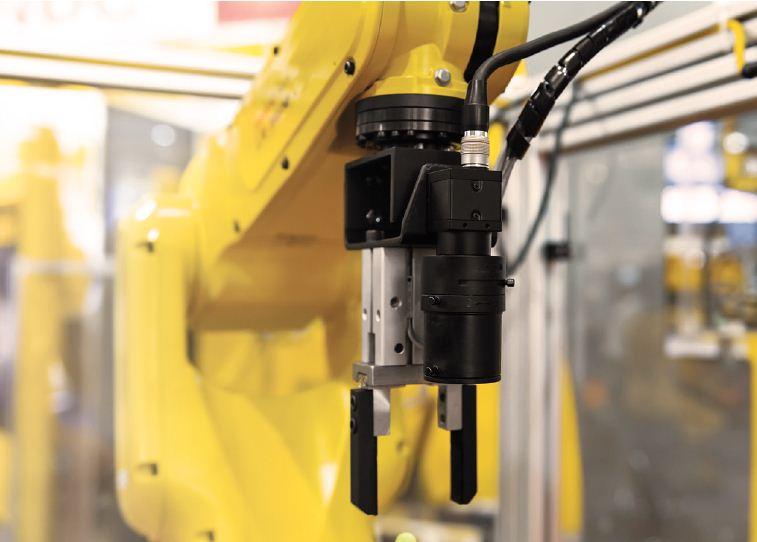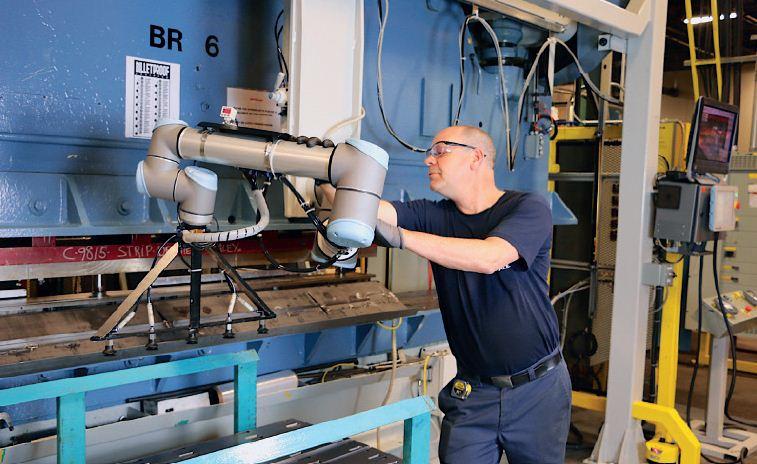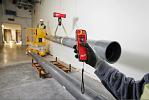- FMA
- The Fabricator
- FABTECH
- Canadian Metalworking
Boosting Productivity with Robots
Besides generating jobs, robots can boost productivity in unexpected ways.
- By Nate Hendley
- December 22, 2015
- Article
- Metalworking
Two years ago, Etalex faced a problem. The solution this Montreal-based manufacturer came up with underlines a once radical notion, that far from being destructive, robots actually create jobs and boost productivity. According to proponents, robots will make North American manufacturers more productive and therefore more competitive against off-shore companies.
Founded in 1966, Etalex manufactures shelving and racks for supermarkets, convenience stores, gas stations, etc. The company currently has around 150 employees, about a third of which are involved in production.
One of these workers spent his day unloading punched parts from a press brake. The job was tedious and potentially dangerous, given how close the employee had to put his hands by the press brake.
The solution—automate the process with a robot—seemed obvious. However, practical considerations made it difficult to carry this out. Not because the company was opposed to robotics: Etalex has been installing robots from Japanese firm FANUC since 2004 and is delighted with their performance for the most part.
The FANUC robots do “many things” in the plant, including “assembly, spot welding, cutting with plasma, palletizing, etc.,” says plant engineer Jean Francois Rousseau.
Helpful as they were, the FANUC industrial robots required safety barriers—cages or fencing—to prevent them from accidentally coming into contact with a plant employee. Such contact might result in injury for the worker. There was limited space in front of the press brake to install such safety measures, however. If Etalex were to automate the press brake job, they needed a compact robot that didn’t require a safety cage or fence.
Etalex found its solution in the form of UR10, a robotic arm from Danish firm Universal Robots. While traditional industrial robots are bolted in place, the UR10 is small and light enough to be moved around. The six-axis robot arm weighs only 28.9 kilos (63.7 pounds), with a payload of 10 kilos (22 pounds) and a working radius of 1,300 mm (51.2 inches). The UR10 boasts a repeatability of +/-0.1 mm /+/-0.0039 inches (4 mils) and control box size (W x H x D) of 475 x 423 x 268 mm (18.7 x 16.7 x 10.6 inches). The robotic arm is programmed via a 12-inch touchscreen.
In addition to being small, the UR10 can be classified as a “collaborative” robot.
“In general, collaborative means a robot that can work side-by-side with people. If it were to see you in the workplace, it would slow down or if it contacted you, it wouldn’t hurt you, unlike traditional industrial robots, which are programmed to complete their cycle and if you’re in the way, that’s not a good thing,” says Jeff Burnstein, president of the Association for Advancing Automation (A3), a pro-robot trade group based in Ann Arbor, Michigan.
Indeed, the UR10 required no safety caging or fencing and came equipped with sensors that could pick up the presence of nearby humans.
“When someone goes into the space of [the UR10],” its speed is automatically reduced, says Rousseau.
The UR10 was installed in January 2014, freeing up seven employee-hours’ worth of labour a day. The person who previously unloaded the press brake by hand was reassigned to more challenging duties. Etalex was so impressed with its UR10, two more were purchased. The company now has a total of 30 robots, 27 from FANUC. The two additional UR10s are being used for palletizing.
Rousseau won’t give exact figures, citing corporate confidentiality, but says robots have allowed Etalex to halve the price of its shelving units and double production while maintaining roughly the same number of workers the firm had a decade ago. He says it took roughly two years to recoup the factory’s investment in the UR10.
Through such measures, Etalex stays competitive.
“We compete with American companies. In Quebec, salaries are not the same as in the United States. They are higher here,” says Rousseau.
Asked how Etalex would be faring without robotics, Rousseau laughs. The company would be closed without robots, he says. The presence of so many robots has “saved 150 jobs,” he adds.
As evidenced by the Etalex example, industrial robots excel at doing work humans might disdain or find difficult to do consistently well.
“Within the manufacturing environment, our robots tend to be used where fast and accurate movements are required, as well as in areas that are dirty, dull and dangerous,” says Nigel Smith, president of TM Robotics (Americas) in Elk Grove Village, Illinois. “Specific examples include pick and place applications, high precision assembly and loading/unloading machines.”
A sales, service and support partner for Toshiba Machine Industrial Robots of Japan, TM Robotics recently showed off two robots—the six-axis TVL500 and THL300 SCARA industrial robots at the Canadian Manufacturing Technology Show (CMTS) in Toronto. Both robots are made with manufacturing in mind.
“As you know, reshoring has been a hot topic in manufacturing for the last few years and we don’t see any sign of it slowing down. We believe that finding a way to keep more manufacturing functions in North America will continue to be a huge area of focus for companies in 2015, 2016 and beyond,” says Smith.
“Adding automation from robots like Toshiba Machine’s is one of the key ways organizations are going to improve productivity and stay competitive. The more efficient companies become, the more streamlined their manufacturing will be, saving them time and budget and eliminating the need for offshoring.”
At present, automotive and food-packaging companies are the biggest users of industrial robots from TM Robotics in Canada, he states. This jives with recent studies.
The German-based International Federation of Robotics released a white paper called “Positive Impact of Industrial Robots on Employment” in February 2011. The report estimates that three million manufacturing jobs were created worldwide up to 2008 thanks to robotics. Roughly half of these jobs were in the automotive sector.
“For the future, 700,000 to one million new jobs [will] be created by robots in the next five years,” states the paper.
The paper’s basic conclusion: when industrial robot sales rise, unemployment falls.
In a separate report, the Federation notes that robot sales are rising: “In 2014, robot sales increased by 29 per cent to 229,261 units, by far the highest level ever recorded for one year. Sales of industrial robots to all industries increased compared to 2013. The automotive parts suppliers and the electronics industry were the main drivers of the growth,” reads the IRF’s “World Robotics – Industrial Robots” 2015 survey.
Besides generating jobs, robots can boost productivity in unexpected ways.
“Tedious manual jobs tend to have high turnover, which drives up costs for recruiting and training, while workers who stay in those positions can drag down productivity with low morale. Repetitive operations can make it difficult for human workers to maintain consistent output quality and the use of potentially dangerous equipment can lead to on-the-job injuries,” reads an A3 report titled, “Robots Fuel the Next Wave of U.S. Productivity and Job Growth”.
Released October 2015, this paper strongly supports the position that robots are job creators and productivity enhancers.
“In the last few years, we’ve all seen stories about how robots are going to put everyone out of work. But companies say this isn’t even an issue—robot versus jobs. The issue is staying globally competitive. Some companies said if we didn’t have robots and automation, we’d have zero jobs. We would have to send those jobs to China and shut our company down,” states Burnstein.
So what happens then, when off-shore companies acquire the same robots?
If robots and automation “help our overseas competitors improve quality and production,” that’s even more reason to invest in robotics and automation at home, says Burnstein. If Asian companies in low-cost countries buy the same robots, it would still be risky for North American manufacturers to do business with them, he says. Problems dealing with Asian manufacturers include transportation difficulties, political instability and the risk of losing intellectual property.
“So all things being equal, if everyone is using the same technology, you still have a big advantage being closer to your customer,” he states.
The advent of collaborative robots means manufacturing jobs that were previously off-limits to robotic systems are now open. In manufacturing settings, industrial robots are traditionally used for tasks such as painting, welding, palletizing, packaging and material handling.
As in the case of Etalex, such robots are usually segregated from human workers with safety cages and fencing. The arrival of collaborative robotic systems, however, means robots can be used for assembly work and other jobs alongside human co-workers, without fear of injuring them by accident.
Thanks to advances in technology, robots are also more accessible to smaller manufacturers, say boosters.
“For a long time, there’s been the feeling that robots were for big companies only, not small companies. That they were too costly or too complex or required in-house resources that companies didn’t have,” says Burnstein.
Compact collaborative robots that don’t require elaborate safety gear and feature user-friendly touch-screen technology might appeal to small firms with tight budgets and limited space and technical know-how, he continues.
Robots allow manufacturers to run on a lights out basis, although so far, Etalex has been reluctant to go down this road. The company currently runs two shifts and has no plans to introduce a third in order to run 24/7.
“If something wrong happens with the robot, we don’t want to be producing bad parts all night long,” explains Rousseau.
FANUC is working on a solution that might put some of Rousseau’s worries to rest. The company has teamed up with IT and networking giant Cisco to “establish a secure and reliable Internet connection between FANUC robots operating in our customers’ manufacturing facilities and our cloud-based ZDT Data Center,” says Joe Gazzarato, director of FANUC America’s Customer Resource Center.
ZDT stands for “Zero Down Time” and is “a FANUC cloud-based application that allows us to predict and prevent unexpected downtime events that can occur if a robot component fails during production … by connecting our machines to our cloud-based ZDT Data Center, we can collect data from our robots and routinely analyze the overall health of each machine. If we detect a pending issue, the system notifies the customer and our service team so we can send replacement parts and service personnel to the site to help the customer and prevent an unexpected downtime event,” explains Gazzarato.
The end-result is, less downtime, faster cycle time and higher productivity.
As for the future, it’s almost a given that manufacturers will continue to embrace robots.
“We see a lot of activity in aerospace, electronics (particularly electronics assembly), food and consumer goods…everyone is facing the same challenge, regardless of industry. You have to be able to compete and often using robots and other forms of automation allow you to compete more successfully,” states Burnstein.
Proponents of automation stress again that increased use of robots in manufacturing is a good thing, from both a human resources and productivity perspective.
“It’s always been our view that robots enable companies to operate much more efficiently and in doing so, they’re then able to increase productivity. With a tangible increase in productivity, we find many of our customers have then been able to take that added revenue and use it to hire more skilled workers,” says Smith of TM Robotics. “Robots have proven time and time again they can directly improve a company’s ability to hire more employees.”
About the Author
subscribe now


Keep up to date with the latest news, events, and technology for all things metal from our pair of monthly magazines written specifically for Canadian manufacturers!
Start Your Free Subscription- Industry Events
MME Winnipeg
- April 30, 2024
- Winnipeg, ON Canada
CTMA Economic Uncertainty: Helping You Navigate Windsor Seminar
- April 30, 2024
- Windsor, ON Canada
CTMA Economic Uncertainty: Helping You Navigate Kitchener Seminar
- May 2, 2024
- Kitchener, ON Canada
Automate 2024
- May 6 - 9, 2024
- Chicago, IL
ANCA Open House
- May 7 - 8, 2024
- Wixom, MI






















